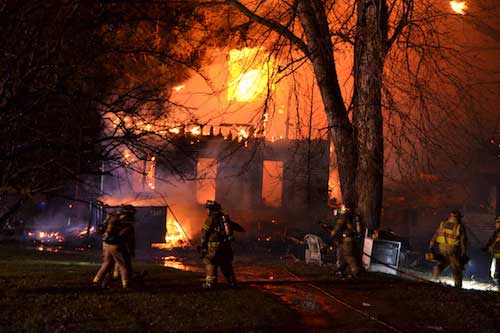With people spending more time at home, state urges fire safety
Press Release, New York State Division of Homeland Security and Emergency Services’ Office of Fire Prevention and Control

File photo by Tom Rivers: Firefighters try to put out a fire at a house in Carlton on Route 18 on Dec. 10, 2017.
The New York State Division of Homeland Security and Emergency Services’ Office of Fire Prevention and Control urged all New Yorkers to keep fire safety in mind as NY-PAUSE remains in effect through May 15.
Approximately 94 percent of all the nation’s fatal structure fires occur in residences and with New Yorkers currently spending more time at home than usual, it’s more important than ever to check your smoke detectors and practice safe behaviors.
“Home fire prevention is the least costly and most effective firefighting anyone can do,” said New York State Homeland Security and Emergency Services Commissioner Patrick Murphy said. “As New Yorkers remain home amidst this global pandemic, the sad fact we must all remember is most deadly fires happen at home. Collectively we have the power to change this. The first step is acknowledging our own personal responsibility in this effort and practicing the safe behaviors we know will prevent fires from happening in the first place.”
If a fire does occur in a home today, a fatality is more likely to occur than 40 years ago. Construction materials, open design concepts and other factors of the building all contribute to a higher probability of death in a home fire. In older homes built with legacy construction, a person could expect to have 15 minutes or more to escape a house fire. By 1980, time to escape a house fire decreased to only eight minutes. Today, a person only has two to three minutes to get out and survive. Fire is fast and it doubles every 30 seconds so in a matter of a couple of minutes, a room or even the whole house may be engulfed.
Cooking, especially when unattended, remains the leading cause of both residential fires and fire deaths in the United States. Cooking may be a good educational opportunity and family activity, especially with more time being spent in the home, however it’s important to remember some basic steps to protect your family from potential fires. This includes making sure cooking is never left unattended, that surfaces are free from grease and that all combustible materials are kept well away from heat sources.
For more cooking fire safety tips, visit the State Office of Fire Prevention and Control website (click here).
“There is an unacceptable number of fatal fires occurring each year, and we must change people’s behaviors today to prevent fires and increase people’s chances of survival,” said State Fire Administrator Francis Nerney. “The good news is that by taking personal responsibility and following a few easy, inexpensive steps, we can dramatically reduce fires and their dreadful consequences. Everyone has the power to make a difference.”
Some additional tips for preventing fires and increasing survivability in the event of a fire:
- First, prevent the fire. If a fire event never happens, none of the loss, injury and death occurs.
- Have working smoke alarms. Working smoke alarms are the most important tool for early notification of fire, escape and survival.
- Have a practiced home escape plan. Know two ways out and practice escaping to a designated meeting point. Escape must be automatic when the alarm sounds. It’s not the time to figure what to do. You must already know your escape route and follow it.
- Consider installing home fire sprinklers. One or two sprinkler heads at the location where the fire starts can control or extinguish the fire, providing invaluable time to escape. Studies show that working smoke alarms and fire sprinklers can together reduce fire deaths by over 80 percent.
The statewide ban prohibiting residential brush burning remains in effect until May 14. With spring approaching, conditions for wildfires are heightened in springtime when most wildfires occur. Open burning of debris is the largest single cause of spring wildfires in New York State.
When temperatures are warmer and the past fall’s debris and leaves dry out, wildfires can start and spread easily and be further fueled by winds and a lack of green vegetation. New York first enacted strict restrictions on open burning in 2009 to help prevent wildfires and reduce air pollution.
The regulations allow residential brush fires in towns with fewer than 20,000 residents during most of the year, but prohibit such burning in spring when most wildfires occur. Since the ban was established, the eight-year annual average number of spring fires decreased by 42.6 percent, from 2,649 in 2009, to 1,521 in 2018.





































































